
94% of researchers rate our articles as excellent or good
Learn more about the work of our research integrity team to safeguard the quality of each article we publish.
Find out more
ORIGINAL RESEARCH article
Front. Physiol. , 23 June 2021
Sec. Environmental, Aviation and Space Physiology
Volume 12 - 2021 | https://doi.org/10.3389/fphys.2021.670640
A correction has been applied to this article in:
Corrigendum: Gravity-Induced Lower-Leg Swelling Can Be Ameliorated by Ingestion of α-Glucosyl Hesperidin Beverage
The most likely cause of lower-leg swelling is prolonged sitting, which sometimes induces deep vein thrombosis, also known as, economy class syndrome. We aimed to clarify the influence of intake of 4G-α-glucopyranosyl hesperidin (G-Hsp) beverage on the lower-leg swelling caused by 6 h of sitting in six healthy women. All subjects ingested 100 mL of G-Hsp or Placebo beverages with 100 mL of mineral water after 10 min of rest in a chair. Subsequently, subjects were requested to sit in the chair in a relaxed position for 6 h with two breaks to walk for urination. Calf water content measured by impedance plethysmography, calf circumference, and calf skin temperature by infrared thermography were measured, along with assessment of calf swelling sensation on a visual analog scale. Increase in ankle % circumference was significantly less after the G-Hsp ingestion (101.8 ± 1.5%) than after placebo (103.3 ± 0.8%; P = 0.004). A significant difference was found between percent circumference after the G-Hsp and the placebo, that is, the calf swelling after the placebo was significantly larger (P = 0.043). A gradual increase in skin temperature at the lower limb was observed after G-Hsp ingestion, while there was no change after placebo. Gravity-induced calf and ankle swelling resulted by prolonged sitting can be ameliorated by oral ingestion of hesperidin-derived G-Hsp through production of nitric oxide. It might be helpful in preventing economy-class syndrome caused by enforced sitting for a long duration.
Foot, ankle, and lower-leg swelling refers to an accumulation of interstitial fluid in the lowest part of the body. It is a type of edema, which is an abnormal accumulation of interstitial fluid (Weber, 1932). Clinically, edema is significant swelling; the amount of interstitial fluid is determined by the balance of fluid homeostasis and the increased secretion of fluid into the interstitium, and the most likely cause of lower-leg swelling is prolonged sitting, which sometimes induces pulmonary embolism or deep vein thrombosis when blood clots leave and move to the lungs (Cruickshank et al., 1977; Lapostolle et al., 2001; Abunnaja et al., 2014). This lower-leg swelling is likely to occur in the lower limb in the daily lives of normal subjects (Yoneyama et al., 2007). In order to prevent this lower-leg swelling, several physical techniques have been implemented including dynamic action (Stick et al., 1992) and compression (Khoshgoftar et al., 2009) of the lower-leg muscles (the tibialis anterior, the soleus, and the gastrocnemius). However, oral ingestion of beverages has not been well examined yet.
The flavonoids including flavanones, flavone, and isoflavon are polyphenols present in the peel of such fruits as the mandarin orange (Citrus unshiu Marc.) in the form of glycosides. Hesperidin, one of the flavanone glycosides, is contained in the skin and flesh of some citrus fruits, and is considered to protect the fruit from ultraviolet rays, namely through vitamin P (Bentsáth et al., 1936). It has been shown to exert many biological activities, including reducing blood cholesterol levels and enhancing blood circulation (Garg et al., 2001). Hesperidin is one of the primary constituents of Citrus unshiu peel but is of limited use because of its low water solubility (Yamada et al., 2006). A hesperidin-derived compound, 4G-α-glucopyranosyl hesperidin (G-Hsp), by transglucosylation using cyclodextrin glucano-transferase (Figure 1) is much more soluble than conventional hesperidin (Kometani et al., 1994). Its absorbance rate to the human body is three times higher than that of hesperidin (Kometani et al., 2008). Moreover, it has been reported that G-Hsp can treat capillary fragility and permeability decrease (Garg et al., 2001; Liu et al., 2008), has an antioxidant effect (Hijiya and Miyake, 1991), and acts as an antiallergic (Galati et al., 1994) and antihypertensive (Galati et al., 1996). Thus, by enhancing the permeability of interstitial fluid into the blood vessel, G-Hsp might reduce lower-leg swelling.
We measured calf water content and calf circumference to examine the effect of G-Hsp ingestion on the prevention of the lower-leg swelling caused by prolonged sitting in healthy women. We hypothesized that the oral ingestion of a beverage containing dissolved G-Hsp would suppress water congestion at the lower leg in middle-aged women during prolonged sitting.
Six healthy women served as the subjects. Their ages were 43 ± 2 years. They were all non-smokers and were taking no medications. They were given sufficient explanation and provided written informed consent. The protocol of the present study was approved by the institutional review board of Aichi Medical University. The study was conducted in accordance with the principles of the Declaration of Helsinki. Subjects were requested to abstain from caffeinated beverages, alcohol, citrus, and spices for at least 12 h before experimental sessions.
The subjects were requested to come to the laboratory at 10:00 h, at least 2 h after a light meal. All subjects were familiarized with the equipment and procedures before any experimental sessions. The experiments were carried out in an artificial climate chamber at an ambient temperature of 26°C and 50% relative humidity. The subjects change clothes a long-sleeved shirt and shorts pants after urination before start of experiments. After measuring of the circumference of the lower leg at the 1/2 and 1/4 sites between the patella and the malleolus of the subjects in a relaxed sitting position at the chair, an impedance electrode was applied halfway between the patella and the first toe. After 10 min of control reading, the subjects ingested 100 mL of test beverage with 100 mL of mineral water (total 200 mL) within a minute. The test beverage either contained dissolved G-Hsp or a placebo. The subjects were requested to come to the laboratory twice on other days, and the order of the beverages was selected at random (double blind study). After ingestion, they sat on a chair in a relaxed position for 6 h. At 2 h and 4 h after ingestion, they were requested to ingest 200 mL of mineral water, and they were allowed to walk for 30 s to the toilet next to the climatic chamber to urinate. During the 6 h of sitting, they were instructed to move as little as possible.
Calf water content was measured by impedance plethysmography using the bioelectrical impedance analysis (BIA) method (Kyle et al., 2004a,b) to analyze the body composition at the lower leg. This method measures the impedance between the two electrodes using an impedance plethysmograph (Nihon Koden AI-601G, Tokyo). Skin temperature at the lower limb was assessed by infrared thermography (Avio TVS-200EX, Tokyo Japan) every 30 min. The calf and ankle perimeters were measured every 30 min using a measuring tape. Subjective symptoms of calf swelling were rated every 30 min using a visual analog scale (VAS) between 0 and 100. Subjective symptoms of calf swelling were rated every 30 min using a VAS. This uses a 100 mm VAS, ranging from 0 (no swelling) to 100 (very severe swelling).
Each subject ingested 100 mL of a beverage containing 1,000 mg of G-Hsp with 100 mL of mineral water. The sweetness (sucrose) and acidic (citric acid) had been added to the beverage for taste the same to placebo beverage. A placebo beverage not containing G-Hsp was used for comparison. G-Hsp and placebo beverage were ingested on the other days in a random order.
All data are shown as the mean ± SE. Statistical significances between G-Hsp and placebo were calculated using two-way analysis of variance (ANOVA) followed by Greenhouse-Geisser or Huynh-Feldt multiple comparison tests. A p-value < 0.05 was considered significant. The VAS assessment was analyzed using the t-test.
Since the impedance of biological tissue is a reciprocal of its water content, a decrease in impedance reflects an increase in water content. The calf impedance decreased gradually during sitting for 6 h after beverage ingestion. The percent difference from the control reading (taken as 100%), impedance tended to be smaller after G-Hsp ingestion than after the placebo (P = 0.053; Figure 2).
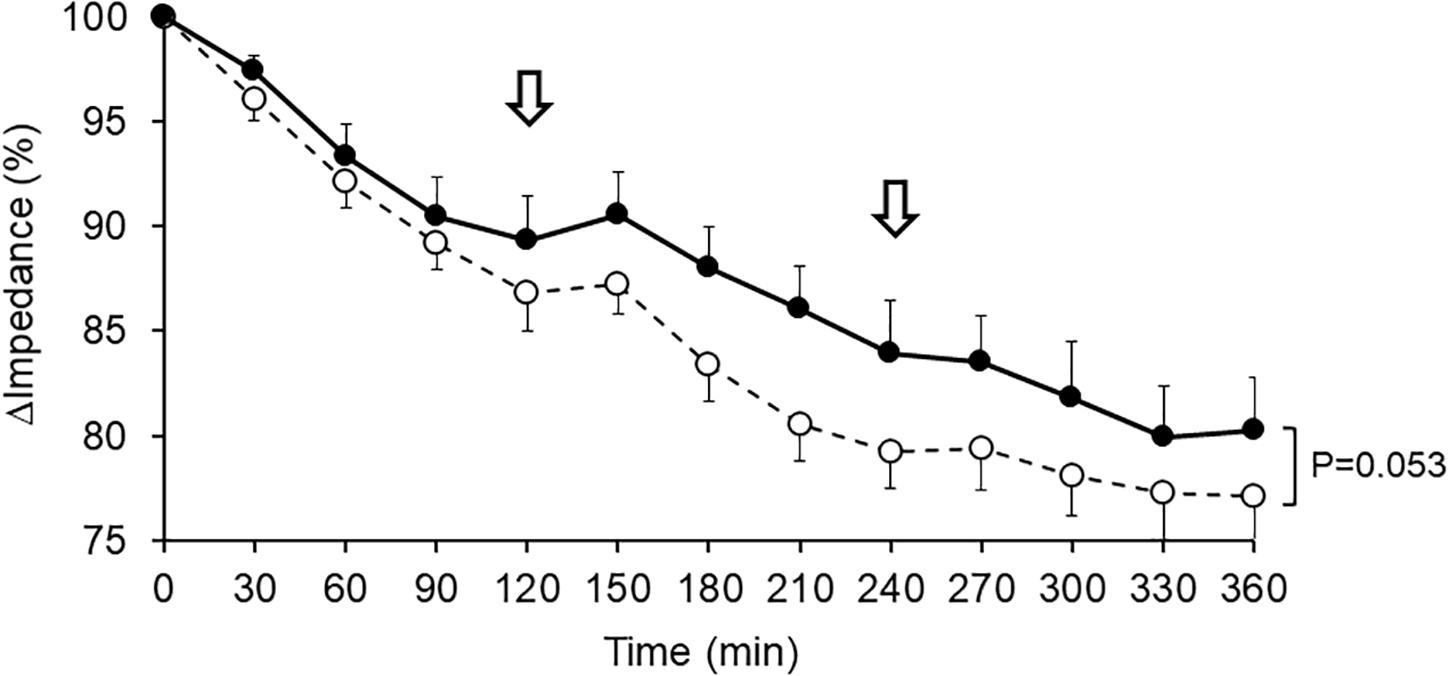
Figure 2. Changes in impedance of the lower leg after 1,000 mg of G-Hsp (•) and Placebo (∘) beverage ingestion. The arrow indicates the walking for urination, mean and SE, n = 6.
The ankle circumference was increased with sitting time, and the absolute values of ankle circumference exhibited significant difference between G-Hsp and placebo (P = 0.002; Figure 3). Furthermore, there was a significant difference between the percent changes in circumference from the control reading after the G-Hsp beverage ingestion and after placebo. The increase in ankle percent circumference was significantly less after the G-Hsp ingestion (101.8 ± 1.5%) than after placebo (103.3 ± 0.8%; P = 0.004; Figure 3).
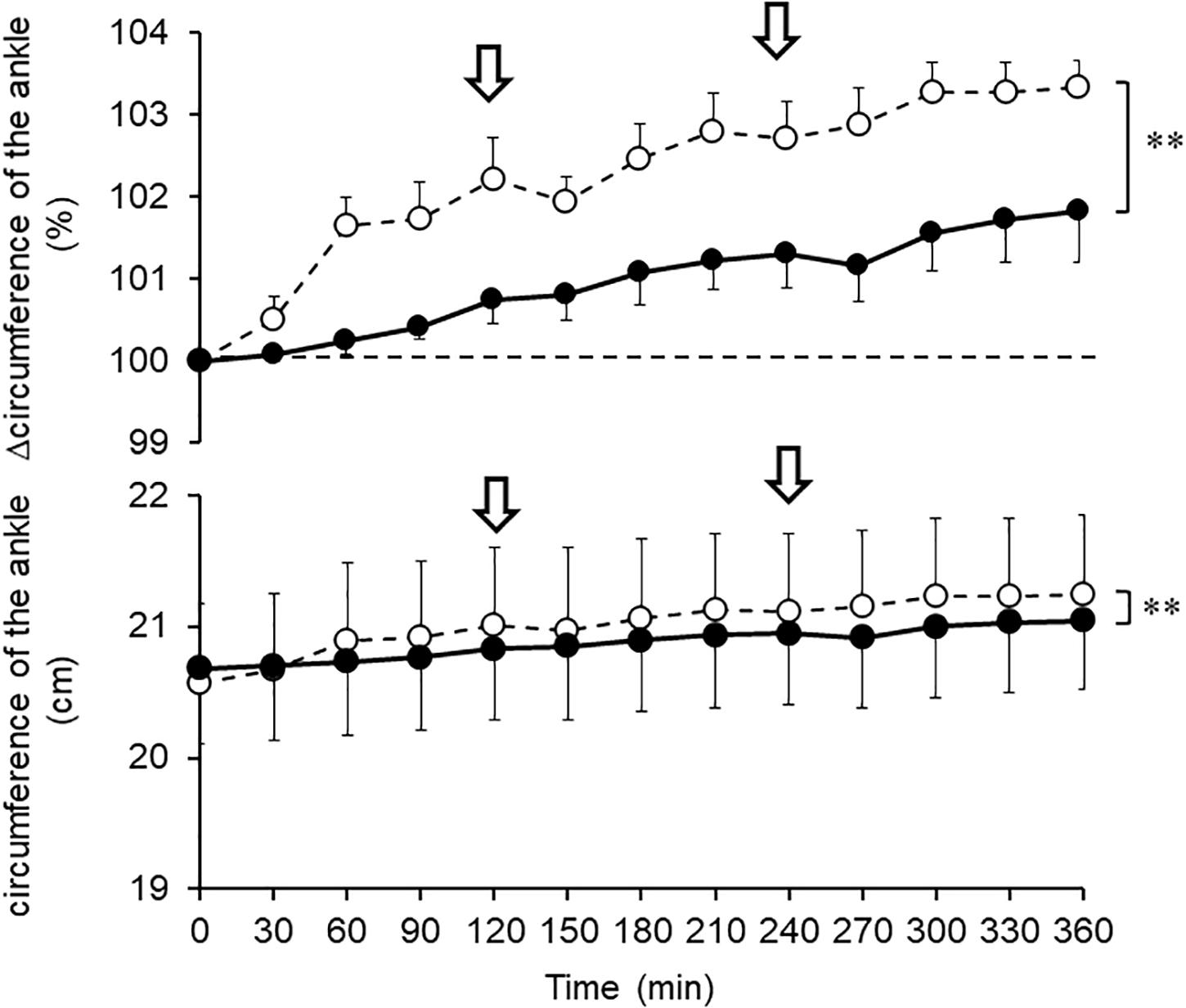
Figure 3. Changes in circumference of the ankle after 1,000 mg of G-Hsp (•) and Placebo (∘) beverage ingestion. The arrow indicates the walking for urination, mean and SE, n = 6, Asterisks indicate significant differences (∗∗P < 0.01).
The calf circumference also increased with sitting time. A significant difference was found between percent circumference after the G-Hsp and the placebo, that is, the calf swelling after placebo was significantly larger (P = 0.043; Figure 4).
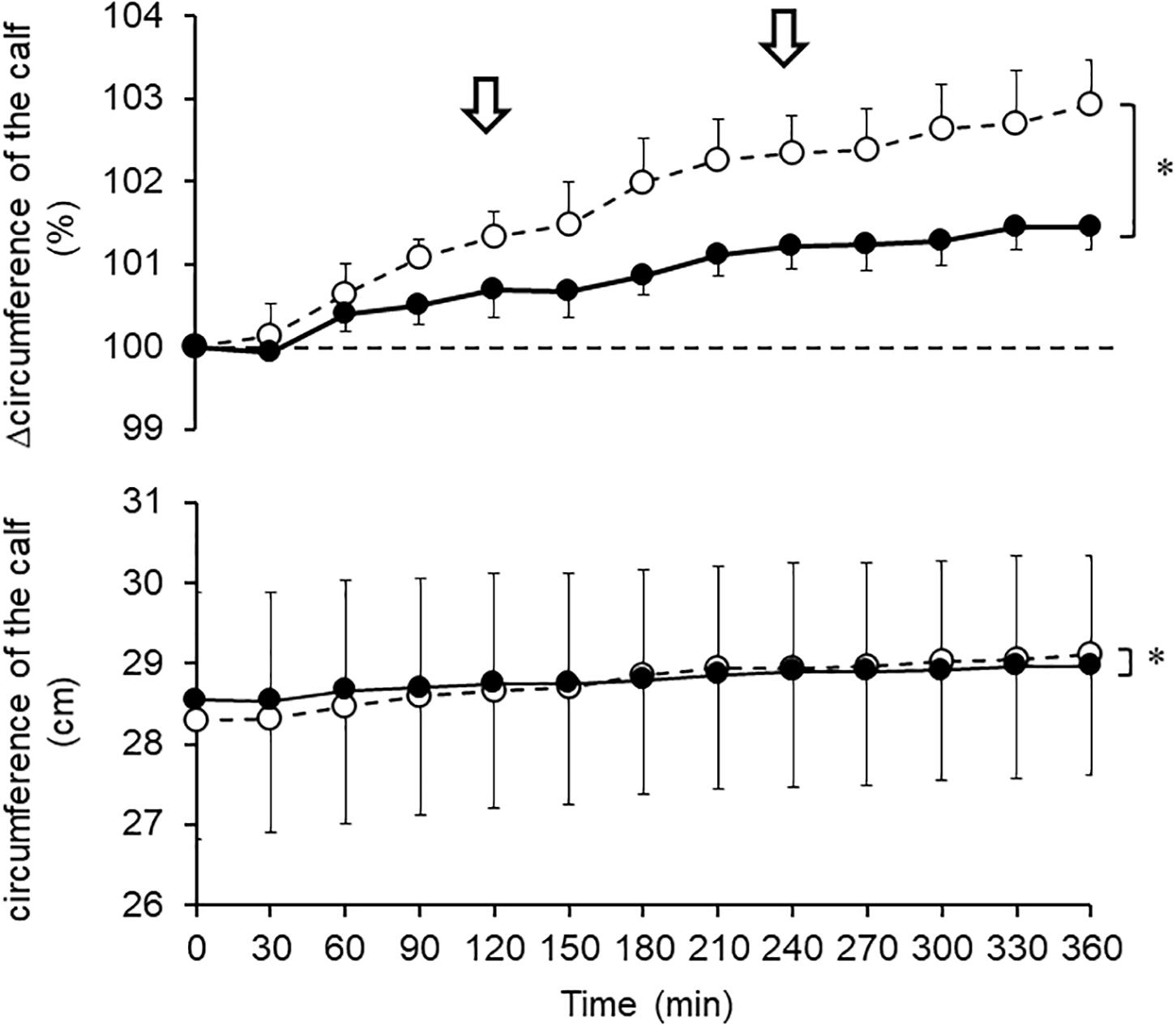
Figure 4. Changes in circumference of the calf after 1,000 mg of G-Hsp (•) and Placebo (∘) beverage ingestion. The arrow indicates the walking for urination, mean and SE, n = 6, Asterisks indicate significant differences (∗P < 0.05).
A typical case of the skin surface temperature change shown by the infrared thermography is illustrated in Figure 5. In the lower-leg area, a gradual increase in the skin surface temperature was observed up to 6 h after G-Hsp ingestion. In contrast, a gradual decrease in the skin surface temperature was seen after placebo ingestion.
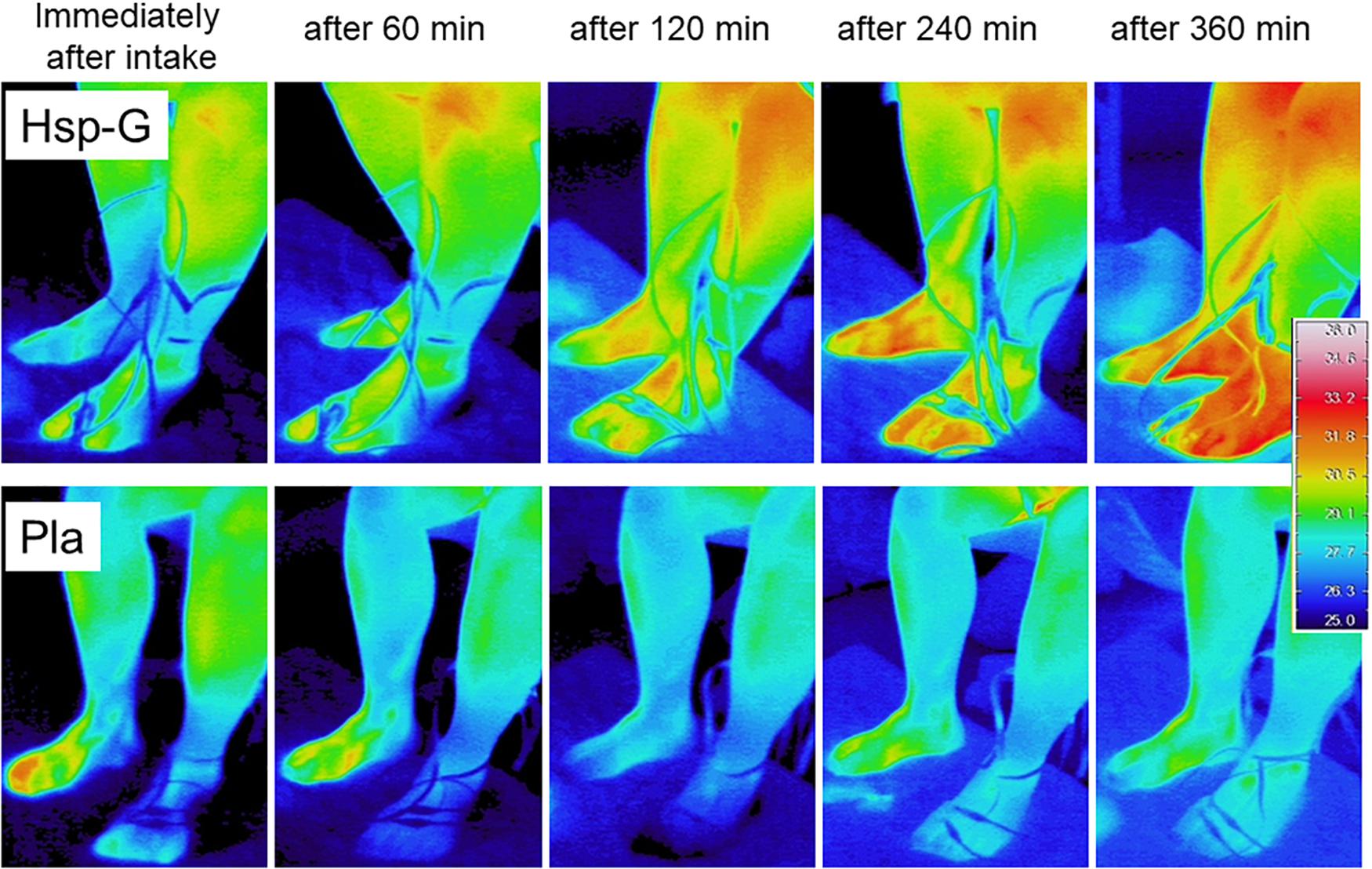
Figure 5. Comparison of skin temperature in the lower leg after 1,000 mg of G-Hsp (upper panel) and Placebo (lower panel) beverage ingestion in a subject.
The VAS score for subjective symptoms of calf swelling is illustrated in Figure 6. The VAS score for subjective symptoms over time tended to be reduced by G-Hsp ingestion. However, the difference from the placebo was not significant.
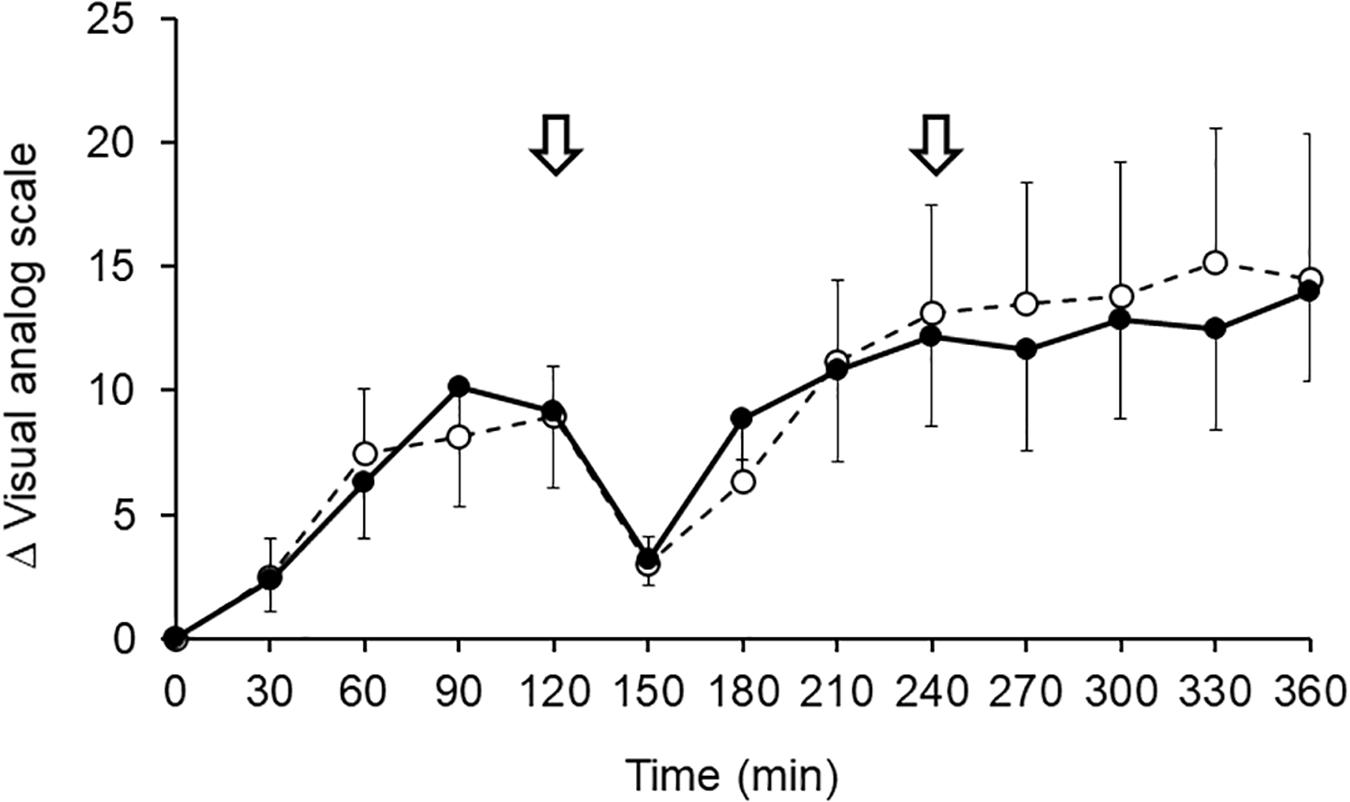
Figure 6. Changes in subjective symptoms of calf swelling using VAS scale after 1,000 mg of G-Hsp (•) and Placebo (∘) beverage ingestion. The arrow indicates the walking for urination, mean and SE, n = 6.
The present study confirmed that the ankle swelling caused by prolonged sitting was ameliorated by the ingestion of a hesperidin derived compound, G-Hsp. This means that the ankle swelling was significantly larger after placebo ingestion.
The main findings of the present study were as follows: (1) the increase in calf water content induced by prolonged sitting as measured by bioimpedance analysis was suppressed by G-Hsp ingestion (Figure 2), (2) increases in the calf and the ankle circumference and subjective symptoms of swelling were suppressed by G-Hsp ingestion (Figures 3, 4, 6) and, (3) increases in skin temperature were facilitated by G-Hsp ingestion (Figure 5).
Symptoms of calf swelling are observed during and after prolonged standing or sitting, especially in women, and especially during pregnancy (Yoneyama et al., 2007). Venous clotting, especially pulmonary embolism or deep vein thrombosis, also known as, economy class syndrome, is one of the serious problems associated with prolonged sitting (Cruickshank et al., 1977; Lapostolle et al., 2001; Abunnaja et al., 2014), and dehydration caused by hypovolemia also contributes to this syndrome (Eklof et al., 1996). Hamada et al. (2002) reported that ionized beverage ingestion significantly ameliorates the condition. However, there has been no report on what kinds of supplement can facilitate the reduction of calf swelling.
4G-α-glucopyranosyl hesperidin is hydrolyzed into hesperidin by intestinal mucosal α-glucosidases, followed by its hydrolysis into aglycone hesperetin by β-glucosidase found in cytoplasm, and its absorption into the human body (Ohtsuki et al., 2002, 2003; Nielsen et al., 2006). It has been reported that G-Hsp is absorbed more efficiently and functions more effectively than hesperidin (Yamada et al., 2006). Various physiological functions of G-Hsp have been reported including serum lipid improvement (Miwa et al., 2005), bone metabolism improvement (Chiba et al., 2013), blood pressure decrease (Yamamoto et al., 2008), and reduced inflammation (Kometani et al., 2008).
In the present study, the calf and ankle swelling caused by prolonged sitting was possibly contributed to by femoral compression that reduced venous return and the effect of hydrostatic congestion in the lower extremities. This increased venous pressure can induce blood plasma to leak out of the vessels, eventually resulting in water retention in the interstitium. This calf and ankle swelling and subjective symptoms of swelling were ameliorated by ingestion of G-Hsp contained beverage.
The skin temperature was increased at 6 h after the G-Hsp ingestion, reflecting improved peripheral circulation through G-Hsp intake. A recent study on the suppression of tympanic and skin temperature decrease by exposure to cold confirmed the vasodilative effect and heat production caused by a G-Hsp ingestion, as well as a warmer sensation, particularly in women with high sensitivity to cold in the lower legs (Takumi et al., 2010). They administrated oral G-Hsp to the women for 4 weeks, and the subjects’ discomfort related to blood circulation and autonomic nervous system was ameliorated. In addition to this chronic administration study, the present acute administration study confirmed the effectiveness of G-Hsp on prevention of calf and ankle swelling as well as skin temperature maintenance.
The mechanism of blood circulatory improvement is considered to be dependent on nitric oxide production, inducing vascular dilatation (Takumi et al., 2011), since oral administration of G-Hsp for 3 weeks has been proved to promote nitric oxide production, reduced inflammation, and improved vascular endothelial cells (Rizza et al., 2011). In animal studies, administration of G-Hsp to spontaneous hypertensive rats were found to increase the bioavailability of smooth muscles, resulting in an increase in peripheral circulation and a decrease in systemic blood pressure (Yamamoto et al., 2008). Another study on the autonomic nervous system showed that G-Hsp administration to healthy women led to a significantly lower LF/HF ratio and higher HF component in heart rate variability, indicating vagal tone increase after ingestion of G-Hsp (Takumi et al., 2010).
In conclusion, gravity-induced calf and ankle swelling resulted by prolonged sitting can be ameliorated by oral ingestion of hesperidin-derived G-Hsp through production of nitric oxide. This may help people who complain of discomfort from lower-leg swelling and may provide a good measure for preventing economy-class syndrome.
The raw data supporting the conclusions of this article will be made available by the authors, without undue reservation.
The studies involving human participants were reviewed and approved by the Aichi Medical University. The patients/participants provided their written informed consent to participate in this study.
NN and HT decided on the conception and design of the research. NN drafted the manuscript. NN, HT, and KY performed the experiments, analyzed the data, and interpreted the results of the experiments. All authors edited and revised the manuscript and read and approved the final manuscript.
This study was funded by the Ezaki Glico Co., Ltd. (to SI). The funding body had no role in the design of this study, data collection, interpretation of data, or in writing of the manuscript.
HT was employed by the Ezaki Glico Co., Ltd., Osaka, Japan.
The remaining authors declare that the research was conducted in the absence of any commercial or financial relationships that could be construed as a potential conflict of interest.
We appreciate the effort spent by volunteer subjects in this study. This study was performed as the cooperative research between Aichi Medical University and Ezaki Glico Co., Ltd.
Abunnaja, S., Clyde, M., Cuviello, Brenes, R. A., and Tripodi, G. (2014). Concomitant deep venous thrombosis, femoral artery thrombosis, and pulmonary embolism after air travel. Case Rep. Vasc. Med. 2014, 1–4. doi: 10.1155/2014/174147
Bentsáth, A., Rusznyák, S. T., and Szent-Györgyi, A. (1936). Vitamin nature of flavones. Nature 138:798.
Chiba, H., Uehara, M., Wu, J., Wang, X., Masuyama, K., Suzuki, K., et al. (2013). Hesperidin, a citrus flavonoid, inhibits bone loss and decreases serum and hepatic lipids in ovariectomized mice. J. Nutr. 133, 1892–1897. doi: 10.1093/jn/133.6.1892
Cruickshank, J. M., Gorlin, R., and Jennett, B. (1977). Air travel and thrombotic episodes: the economy class syndrome. Lancet 332, 497–498. doi: 10.1016/s0140-6736(88)90134-1
Eklof, B., Kistner, R. L., Masuda, E. M., Sonntag, B. V., and Wong, H. P. (1996). Venous thromboembolism in association with prolonged air travel. Dermatol. Surg. 22, 637–641. doi: 10.1111/j.1524-4725.1996.tb00610.x
Galati, E. M., Monforte, M. T., Kirjavainenm, S., Forestieri, A. M., Trovato, A., and Tripodo, M. M. (1994). Biological effects of hesperidin, a citrus flavonoid. (Note I): anti-inflammatory and analgesic activity. Farmaco 40, 709–712.
Galati, E. M., Trovato, A., Kirjavainenm, S., Forestieri, A. M., Rossitto, A., and Monforte, M. T. (1996). Biological effects of hesperidin, a citrus flavonoid. (Note III): antihypertensive and diuretic activity in rat. Farmaco 51, 219–221.
Garg, A., Garg, S., Zaneveld, L. J., and Singla, A. K. (2001). Chemistry and pharmacology of the citrus bioflavonoid hesperidin. Phytother. Res. 15, 655–669. doi: 10.1002/ptr.1074
Hamada, K., Doi, T., Sakurai, M., Matsumoto, K., Yanagisawa, K., Suzuki, T., et al. (2002). Effects of hydration on fluid balance and lower-extremity blood viscosity during long airplane flights. JAMA 287, 844–845. doi: 10.1001/jama.287.7.844-a
Hijiya, H., and Miyake, T. (1991). Alpha-glycosyl hesperidin, and its preparation and uses. European Patent Publication. No 0402049. Munich: European Patent Office.
Khoshgoftar, Z., Esfahani, A. F., Marzban, M., Omran, A. S., Ghasemi, A. H., Movaghar, S., et al. (2009). Comparison of compression stocking with elastic bandage in reducing postoperative edema in coronary artery bypass graft patient. J. Vasc. Nurs. 27, 103–106. doi: 10.1016/j.jvn.2009.09.004
Kometani, T., Terada, Y., Nishimura, T., Takii, H., and Okada, S. (1994). Transglycosylation to Hesperidin by Cyclodextrin Glucanotransferase from an Alkalophilic Bacillus Species in Alkaline pH and Properties of Hesperidin Glycosides. Biosci. Biotechnol. Biochem. 58, 1990–1994. doi: 10.1271/bbb.58.1990
Kometani, T., Fukuda, T., Kakuma, T., Kawaguchi, K., Tamura, W., Kumazawa, Y., et al. (2008). Effects of α-glucosylhesperidin, a bioactive food material, on collagen induced arthritis in mice and rheumatoid arthritis in humans. Immnopharmacol. Immunotoxicol. 30, 117–134. doi: 10.1080/08923970701812688
Kyle, U. G., Bosaeus, I., De Lorenzo, A. D., Deurenberg, P., Elia, M., Gómez, J. M., et al. (2004a). Bioelectrical impedance analysis- part I: review of principles and methods. Clin. Nutr. 23, 1226–1243. doi: 10.1016/j.clnu.2004.06.004
Kyle, U. G., Bosaeus, I., De Lorenzo, A. D., Deurenberg, P., Elia, M., Gómez, J. M., et al. (2004b). Bioelectrical impedance analysis-part II: utilization in clinical practice. Clin. Nutr. 23, 1430–1453. doi: 10.1016/j.clnu.2004.09.012
Lapostolle, F., Surget, V., Borron, S. W., Desmaizières, M., Sordelet, D., Lapandry, C., et al. (2001). Severe pulmonary embolism associated with air travel. N. Engl. J. Med. 345, 779–783. doi: 10.1056/NEJMoa010378
Liu, L., Xu, D. M., and Cheng, Y. Y. (2008). Distinct effects of naringenin and hesperetin on nitric oxide production from endothelial cells. J. Agric. Food. Chem. 56, 824–829. doi: 10.1021/jf0723007
Miwa, Y., Mitsuzumi, T., Sunayama, T., Yamada, M., Okada, K., Kubota, M., et al. (2005). Glucosyl hesperidin lowers serum triglyceride level in hypertriglyceridemic subjects through the improvement of very low-density lipoprotein metabolic abnormality. J. Nutr. Sci. Vitaminol. 51, 460–470. doi: 10.3177/jnsv.51.460
Nielsen, I. L., Chee, W. S., Poulsen, L., Offord-Cavin, E., Rasmussen, S. E., Frederiksen, H., et al. (2006). Bioavailability is improved by enzymatic modification of the citrus flavonoid hesperidin in humans: a randomized, double-blind, crossover trial. J. Nutr. 136, 404–408. doi: 10.1093/jn/136.2.404
Ohtsuki, K., Abe, A., Mitsuzuwi, H., Kondo, M., Uemura, K., Iwasaki, Y., et al. (2002). Effects of long-term administration of hesperidin and glucosyl hesperidin to spontaneously hypertensive rats. J. Nutr. Sci. Vitaminol. 48, 420–422. doi: 10.3177/jnsv.48.420
Ohtsuki, K., Abe, A., Mitsuzuwi, H., Kondo, M., Uemura, K., Iwasaki, Y., et al. (2003). Glucosyl hesperidin improves serum cholesterol composition and inhibits hypertrophy in vasculature. J. Nutr. Sci. Vitaminol. 49, 447–450. doi: 10.3177/jnsv.49.447
Rizza, S., Muniyappa, R., Iantorno, M., Kim, J. A., Chen, H., Pullikotil, P., et al. (2011). Citrus polyphenol hesperidin stimulates production of nitric oxide in endothelial cells while improving endothelial function and reducing inflammatory markers in patients with metabolic syndrome. J. Clin. Endcrinol. Metab. 96, E782–E792. doi: 10.1210/jc.2010-2879
Stick, C., Jaeger, H., and Witzleb, E. (1992). Measurements of volume changes and venous pressure in the human lower leg during walking and running. J. Appl. Physiol. 72, 2063–2068. doi: 10.1152/jappl.1992.72.6.2063
Takumi, H., Fujishima, N., Shiraishi, K., Mori, Y., Ariyama, A., Kometani, T., et al. (2010). Effects of alpha-glucosylhesperidin on the peripheral body temperature and autonomic nervous system. Biosci. Biotechnol. Biochem. 74, 707–715. doi: 10.1271/bbb.90742
Takumi, H., Nakamura, H., Kamasaka, H., Kometani, T., Nadamoto, T., Terao, J., et al. (2011). Effects of α-Glucosyl hesperidin on the blood circulation. Bull. Appl. Glycosci. 1, 186–193.
Yamada, M., Tanabe, F., Arai, N., Mitsuzumi, H., Miwa, Y., Kubota, M., et al. (2006). Bioavailability of glucosyl hesperidin in rats. Biosci. Biochnol. Biochem. 70, 1386–1394. doi: 10.1271/bbb.50657
Yamamoto, M., Suzuki, A., and Hase, T. (2008). Short-term effects of glucosyl hesperidin and hesperetin on blood pressure and vascular endothelial function in spontaneously hypertensive rats. J. Nutr. Sci. Vitaminol. 54, 95–98. doi: 10.3177/jnsv.54.95
Yoneyama, M., Yatsuzuka, M., Ishida, Y., Shinmen, N., Hara, Y., and Matsui, A. (2007). The present status of the foot trouble and its care in college students. J. Nurs. Soc. Univ. Toyama 6, 27–35. doi: 10.15099/00002602
Keywords: 4G-α-glucopyranosyl hesperidin, lower leg swelling, vascular permeability, gravity, skin surface temperature
Citation: Nishimura N, Iwase S, Takumi H and Yamamoto K (2021) Gravity-Induced Lower-Leg Swelling Can Be Ameliorated by Ingestion of α-Glucosyl Hesperidin Beverage. Front. Physiol. 12:670640. doi: 10.3389/fphys.2021.670640
Received: 22 February 2021; Accepted: 30 April 2021;
Published: 23 June 2021.
Edited by:
Airong Qian, Northwestern Polytechnical University, ChinaReviewed by:
Jochen Zange, German Aerospace Center, Helmholtz Association of German Research Centers (HZ), GermanyCopyright © 2021 Nishimura, Iwase, Takumi and Yamamoto. This is an open-access article distributed under the terms of the Creative Commons Attribution License (CC BY). The use, distribution or reproduction in other forums is permitted, provided the original author(s) and the copyright owner(s) are credited and that the original publication in this journal is cited, in accordance with accepted academic practice. No use, distribution or reproduction is permitted which does not comply with these terms.
*Correspondence: Naoki Nishimura, bm5hb2tpQG4tZnVrdXNoaS5hYy5qcA==
Disclaimer: All claims expressed in this article are solely those of the authors and do not necessarily represent those of their affiliated organizations, or those of the publisher, the editors and the reviewers. Any product that may be evaluated in this article or claim that may be made by its manufacturer is not guaranteed or endorsed by the publisher.
Research integrity at Frontiers

Learn more about the work of our research integrity team to safeguard the quality of each article we publish.